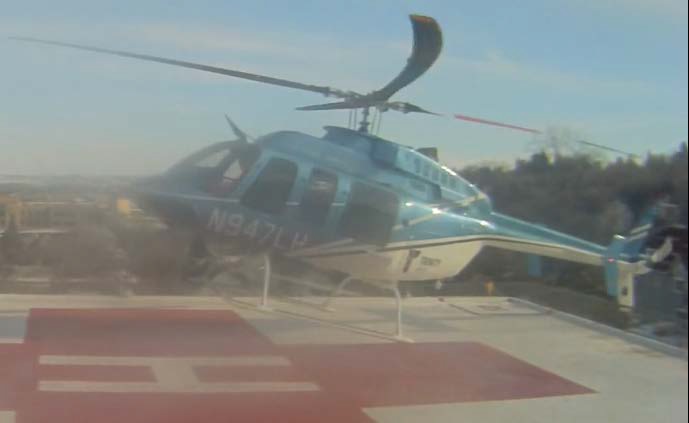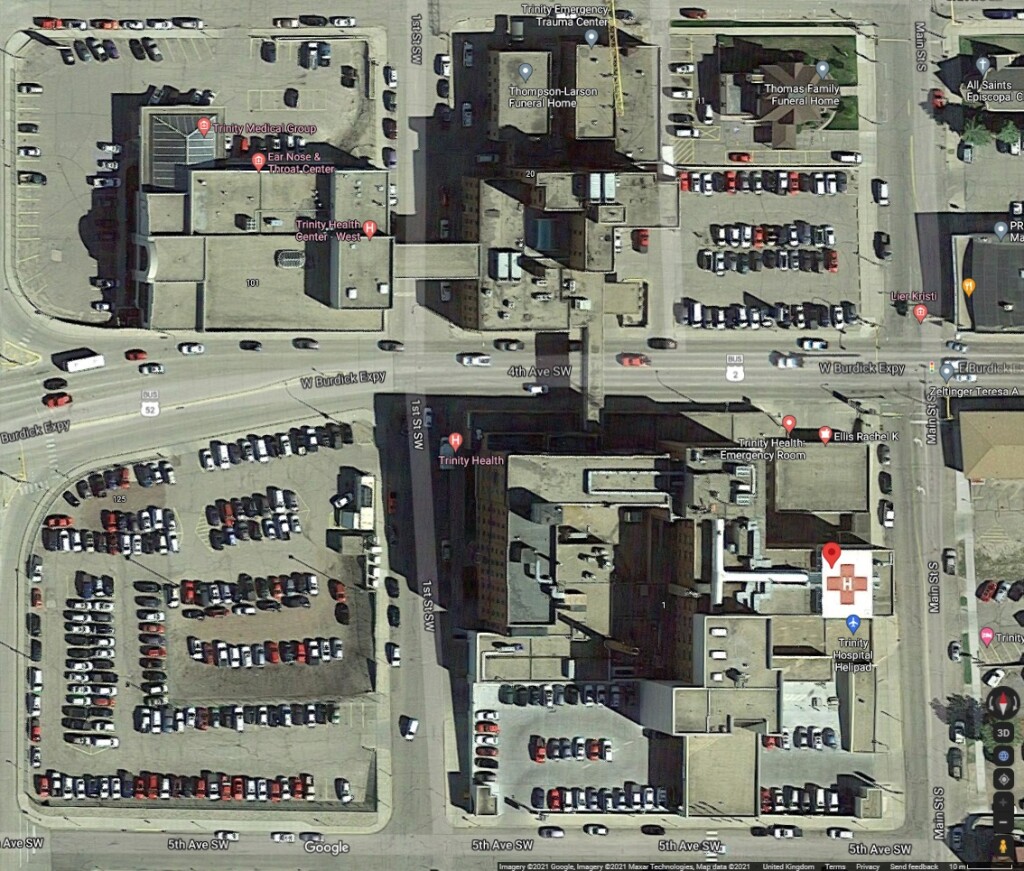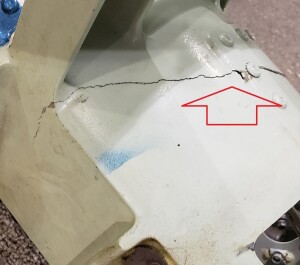Air Ambulance B407 Hospital Helipad Deck Edge Tail Strike During Shallow Approach (N947LH)
On the afternoon of 22 January 2019 Executive Air Taxi Corp Bell 407 N947LH, an air ambulance operated for Trinity Health‘s NorthStar Criticair service, suffered a tail strike during a landing at the Trinity Medical Helipad (2ND4) near Minot, North Dakota. The pilot was uninjured, but the helicopter sustained substantial damage.
The Accident and Safety Investigation
The US National Transportation Safety Board (NTSB) explain in their safety investigation report (published 5 May 2021) that the aircraft was due to pick up a medical crew and was operating a Part 91 positioning flight.
The pilot [6341 hours total, 98 on type] stated he performed a right 180° circling approach to the helipad.
The helipad was on top of a 5-storey hospital building.
“Enroute I punched up ATIS on the radio to confirm winds and they were NW (300 degrees) winds at 7 knots. So I flew over the big church (northeast of the pad a couple of blocks) and then performed a 180 right circling approach to the pad”. As he finished the turn, he thought he was a little low on final approach and “pulled in a little collective.” He applied more collective as he was levelling off and the “helicopter contacted the pad firmly.”
Still from Security CCTV of the Landing of Bell 407 N947LH at the Trinity Medical Helipad (Credit: via NTSB)
The pilot added that it was firmer than a normal landing, but he thought everything was okay until he noticed a small vibration.
Fortuitously:
Before departing with the medical crew, the pilot still felt the vibration in the helicopter, so he shut the helicopter down to check. After shutdown, the crew walked toward the tail and noticed a slight bend in the lower vertical fin, the tips of both tail rotor blades missing, and the helipad safety fence [i.e. the helideck perimeter netting] was missing a small section of the fence-edge pipe.
Subsequent examination of the helicopter identified surprisingly large cracks in the tailboom structure. The helicopter was removed by crane.
NTSB Probable Cause
The pilot’s failure to maintain clearance from fencing around the landing pad during landing, which resulted in the tail rotor contacting the fence.
But What About Flight Data Monitoring?
Oddly, there is no mention of the any flight data being analysed. Data can usually be extracted from GPS units for example if investigators are minded to make an effort. However, the FAA changed Part 135 in 2017 so that helicopter air ambulance operators had to comply with a new Flight Data Monitoring (FDM) System requirement, FAR 135.607:
After April 23, 2018, no person may operate a helicopter in air ambulance operations unless it is equipped with an approved flight data monitoring system capable of recording flight performance data.
FAA AC 135-14B Helicopter Air Ambulance (HAA) Operations explains that:
The FDMS should record digital or analog raw data, images, cockpit voice or ambient audio recordings or any combinations thereof which ideally yield at least the following flight information: • Location; • Altitude; • Heading; • Speeds (airspeed and groundspeed); • Pitch, yaw, and roll attitudes and rate of change; • Engine parameters; • Main rotor RPM; • Ambient acoustic data; • Radio ambient audio; and • Any other parameter the operator deems necessary (e.g., high definition video recording looking forward including instrument panel and forward cockpit windshield view, intercommunications system (intercom) between pilot and medical crew, communications with air traffic control (ATC), OCS, base operations, first responders at scene, hospital, etc.)
So while this sector was classified as a Part 91 positioning flight, its very next flight would have required a suitable FDM System. It would be very unusual to have planned to turn the system off for sectors it was not legally required.
Safety Resources
The European Safety Promotion Network Rotorcraft (ESPN-R) has a helicopter safety discussion group on LinkedIn. You may also find these Aerossurance articles of interest:
- NTSB on LA A109S Rooftop Hospital Helipad Landing Accident
- Air Ambulance Helicopter Fell From Kathmandu Hospital Helipad (Video)
- US Air Ambulance Near Miss with Zip Wire and High ROD Impact at High Density Altitude
- Hanging on the Telephone… HEMS Wirestrike
- Air Ambulance Helicopter Downed by Fencing FOD
- Ambulance / Air Ambulance Collision
- Beware Last Minute Changes in Plan
- Grand Canyon Air Tour Tragic Tailwind Landing Accident
- A Short Flight to Disaster: A109 Mountain CFIT in Marginal Weather
- US Fatal Night HEMS Accident: Self-Induced Pressure & Inadequate Oversight
- HEMS A109S Night Loss of Control Inflight (N91NM)
- Air Ambulance A109S Spatial Disorientation in Night IMC (N11NM)
- Dim, Negative Transfer Double Flameout
- US HEMS EC135P1 Dual Engine Failure: 7 July 2018
- Misassembled Anti-Torque Pedals Cause EC135 Accident.
- Taiwan NASC UH-60M Night Medevac Helicopter Take Off Accident
- Fatal Fatigue: US Night Air Ambulance Helicopter LOC-I Accident
- Deadly Dusk Air Ambulance Bird Strike
- HEMS Black Hole Accident: “Organisational, Regulatory and Oversight Deficiencies”
- HEMS S-76C Night Approach LOC-I Incident
- Life Flight 6 – US HEMS Post Accident Review
- US HEMS “Delays & Oversight Challenges” – IG Report
- US HEMS Accident Rates 2006-2015
- More US Night HEMS Accidents
- That Others May Live – Inadvertent IMC & The Value of Flight Data Monitoring
- Fatal US Helicopter Air Ambulance Accident: One Engine was Failing but Serviceable Engine Shutdown
- Wire Strike on Unfamiliar Approach Direction to a Familiar Site
- S-76A++ Rotor Brake Fire
- Firefighting AW139 Loss of Control and Tree Impact
- Loss of Bell 412 off Brazil Remains Unexplained
- UPDATE 17 July 2021: Sécurité Civile EC145 Mountain Rescue Main Rotor Blade Strike Leads to Tail Strike
- UPDATE 31 July 2021: Low Recce of HEMS Landing Site Skipped – Rotor Blade Strikes Cable Cutter at Small, Sloped Site
- UPDATE 21 August 2021: Air Methods AS350B3 Night CFIT in Snow
- UPDATE 19 September 2021: A HEMS Helicopter Had a Lucky Escape During a NVIS Approach to its Home Base
- UPDATE 20 October 2021: RLC B407 Reverses into Sister Ship at GOM Heliport
- UPDATE 23 December 2021: Air Methods AS350B3 Air Ambulance Tucson Tail Strike
- UPDATE 15 January 2022: Air Ambulance Helicopter Struck Ground During Go-Around after NVIS Inadvertent IMC Entry
- UPDATE 22 January 2022: Pedestrian Seriously Injured by Air Ambulance Landing at Melbourne Hospital
- UPDATE 26 February 2022: Air Ambulance Leaps into Air: Misrigged Flying Controls
- UPDATE 29 April 2022: US Air Ambulance Helicopter Hospital Heliport Tail Strike
- UPDATE 21 January 2023:After Landing this HEMS Helicopter Suddenly Started to Slide Towards it’s Hangar…







Recent Comments